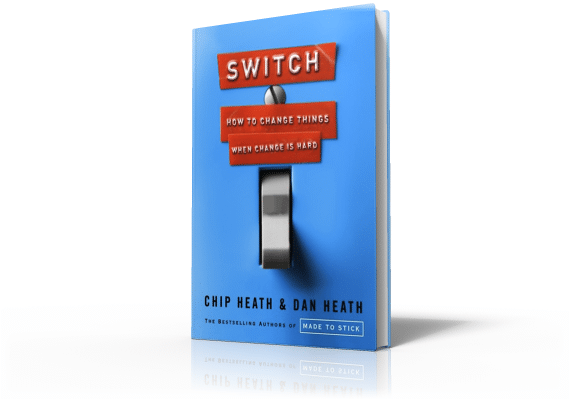
I mentioned a couple of days ago that I had read a couple of books which really helped. Here's the second, which I actually listened to while driving around the corn-filled state of Indiana.
How to change things when change is hard. Seriously, who hasn't dreaded trying to change something? Chip and Dan Heath have written a great how to for all of us. Switch; How to Change Things When Change is Hard.
No matter what area of life you are in, change does not come naturally nor does it come easy. Chip and Dan point out how all of us have an identity crisis. We can want something with our heads without wanting it at all with our hearts. Or even vice versa.
So they dispense with several myths about change. One in particular that stands out is the idea that people are lazy. A very interesting double study, which included chocolate chip cookies (thus piquing my interest) showed that some people who struggle for change are simply tired. Confused? Here's what happened:
A group of researchers brought in a group of hungry college students and placed down a plate of fresh cookies and a plate of radishes. One group was told they could eat the radishes. The other; the cookies. Obviously one group is going to be happy while the other is not. But this was not the real study.
As this was happening, another group of researchers entered the room and said they were conducting a study on who was smarter; college students or high school students. Challenge accepted. The college students were given a set of pictures they had to recreate without lifting their pencil. In reality, the test was designed to be impossible. But what they discovered is that the cookie eaters tried twice almost twice as long as the radish eaters. They concluded the radish eaters had already worked hard at resisting the cookies. Thus, they only had so much energy to give to solving impossible problems.
From this point on, Chip and Dan had my attention. We all know change is hard, but they were speaking to the deeper and basic reasons why coming to a point of change was so difficult.
The rider and the elephant is the illustration carried throughout the book. They write that we can rationalize with people, even explaining to a guy on an elephant where we desire him to go. But nobody can rationalize to an elephant. Either it wants to go somewhere or it doesn't. And it does not matter if the rider wants to go. If the mammoth beast does not want to go, you're not going.
Understanding this split personality in all of us leads us to understanding that we need to speak to our rational side (the rider of the elephant). But perhaps more importantly, we need to convince our emotional side (the elephant).
I won't go into all of the steps here, What I picked up is the need for more creativity when it comes to change. This will be key no matter the change. From diet and exercise to institutional overhaul at your job, change can be accomplished if we remember that everyone struggles with change, but acceptance come when we show the real need.
This book was filled with great stories and illustrations that showed, over and over again, the need to communicate well the need for change. Of course, having a solution to put in place is the perfect second step.
Comments